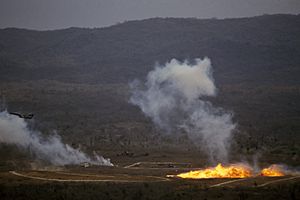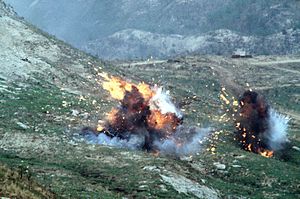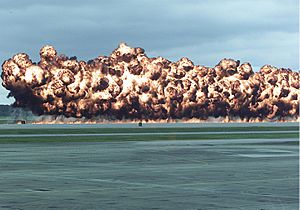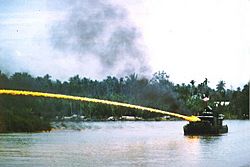Napalm facts for kids
Napalm is the name for a number of flammable liquids that have been used in warfare. Often it is jellied gasoline. Napalm is actually the thickener in such liquids. When it is mixed with gasoline, the thickener makes a sticky incendiary gel. It was developed by the U.S. in World War II by a team of Harvard chemists. The team leader was Louis Fieser. The name napalm has comes from the ingredients that were first used to make it: coprecipitated aluminum salts of naphthenic and palmitic acids. These were added to the flammable substance to cause it to gel.
One of the major problems of early incendiary fluids (such as those used in flamethrowers) was that they splashed and drained too easily. The U.S. found that flamethrowers that use a gasoline gel are able to shoot farther and are more useful. Gasoline gel was difficult to manufacture because it used natural rubber, which was in high demand and expensive. Napalm provided a far cheaper alternative. It solved the problems involved with rubber-based incendiaries.
Nowadays, napalm is mostly made of benzene and polystyrene, and is known as napalm-B.
Napalm was used in flamethrowers and bombs by the U.S. and Allied forces, to increase the usefulness of flammable liquids. Napalm is made to burn at a specific rate and stick to materials. This is done by mixing different of amounts of napalm and other materials. Another useful (and dangerous) effect, primarily involving its use in bombs, was that napalm "rapidly deoxygenates the available air." It also creates large amounts of carbon monoxide causing suffocation. Napalm bombs were also used in the Vietnam War to clear landing zones for helicopters.
Though napalm was a 20th century invention, it is part of a long history of incendiary materials in warfare. However, historically, it was primarily liquids that were used (see Greek fire). An infantry-based flammable liquid fuel weapon, the flamethrower, was introduced in World War I by the Germans, variations of which were soon developed by other sides in the conflict.
Usage in warfare
On July 17, 1944, napalm incendiary bombs were dropped for the first time by American P-38 pilots on a fuel depot at Coutances, near St. Lô, France. Napalm bombs were first used in the Pacific Theatre during the Battle of Tinian by Marine aviator. Its use was complicated because of problems with mixing, fusing and the release mechanisms. In World War II, Allied forces bombed cities in Japan with napalm, and used it in bombs and flamethrowers in Germany and the Japanese-held islands. It was used by the Greek army against communist guerrilla fighters during the Greek Civil War, by United Nations forces in Korea, by Mexico in the late 1960s against guerrilla fighters in Guerrero and by the United States during the Vietnam War.
The most well-known method of delivering napalm is from air-dropped incendiary bombs. A lesser-known method is the flame throwers used by combat infantry. Flame throwers use a thinner version of the same jellied gasoline to destroy gun emplacements, bunkers and cave hideouts. U.S. Marines fighting on Guadalcanal found them very effective against Japanese positions. The Marines used fire as both a casualty weapon as well as a psychological weapon. Men have a natural fear of fire. They found that Japanese soldiers would abandon positions in which they fought to the death against other weapons. Prisoners of war confirmed that they feared napalm more than any other weapon thrown at them.
Napalm became one of the preferred weapons of the Korean War. Pilots returning from the war zone often remarked they would rather have a couple of gasoline tanks full of napalm to drop than any other weapon, bombs, rockets or guns. The U.S. Air Force and Navy used napalm with great effect against all manner of targets to include troops, tanks, buildings and even rail road tunnels. The demoralizing effect napalm had on the enemy became apparent when scores of North Korean troops began to surrender to aircraft flying overhead. Pilots noted they saw surviving enemy troops waving white flags on subsequent passes after dropping napalm. The pilots radioed to ground troops and the North Koreans were captured.
Napalm has been used recently in wartime by or against: Iran (1980–88), Israel (1967, 1982), Nigeria (1969), Brazil (1972), Egypt (1973), Cyprus (1964, 1974), Argentina (1982), Iraq (1980–88, 1991, 2003 – ?), Serbia (1994), Turkey (1963, 1974, 1997), Angola, United States.
In some cases, napalm disables and kills its victims very quickly. Those who do survive suffer up to 5th degree burns. These damage parts of the skin which do not have pain receptors. However, victims who suffer 2nd degree burns from splashed napalm will be in significant amounts of pain.
Philip Jones Griffiths describes its use in Vietnam:
NAPALM. The most effective "anti-personnel" weapon, it is euphemistically described as "unfamiliar cooking fluid" by those apologists for American military methods. They automatically attribute all napalm cases to domestic accidents caused by the people using gasoline instead of kerosene in their cooking stoves. Kerosene is far too expensive for the peasants, who normally use charcoal for cooking. The only "cooking fluid" they know is very "unfamiliar" – it is delivered through their roofs by U.S. planes.
-
"Napalm is the most terrible pain you can imagine," said Phan Thị Kim Phúc, a napalm bombing survivor known from a famous Vietnam War photograph. "Water boils at 100 degrees Celsius. Napalm generates temperatures of 800 to 1,200 degrees Celsius."
Phuc had third-degree burns to half her body and was not expected to live. But thanks to assistance from South Vietnamese photographer Nick Ut, and after surviving a 14-month hospital stay and 17 operations, she became an outspoken peace activist.
International law does not prohibit the use of napalm or other incendiaries against military targets, but use against civilian populations was banned by the United Nations' inhumane weapons convention (often referred to as the CCW) in 1981. Protocol III of the CCW restricts the use of incendiary weapons (not only napalm), but a number of states have not acceded to all of the protocols of the CCW. According to the Stockholm International Peace Research Institute (SIPRI), states are considered a party to the convention, which entered into force as international law in December 1983, if they ratify at least two of the five protocols. The United States, for example, is a party to the CCW but did not sign Protocol III.

Reports by the Sydney Morning Herald suggested that napalm has been used in the Iraq War by US forces. The U.S. Department of Defense denied this. In August 2003, the San Diego Union Tribune said that U.S. Marine pilots and their commanders confirmed the use of Mark 77 firebombs on Iraqi Republican Guards during the start of combat. Official denials of the use of 'napalm' were, however, disingenuous, as the Mk 77 bomb that is currently in service at this time, the Mk 77 Mod 5, does not use actual napalm (e.g. napalm-B). The last U.S. bomb to use actual napalm was the Mark 77 Mod 4, the last of which were destroyed in March 2001. The substance used now is a different incendiary mixture. It is sufficiently analogous in its effects that it is still a controversial incendiary, and can still be referred to colloquially as 'napalm.'
"We napalmed both those (bridge) approaches," said Col. Randolph Alles in a recent interview. "Unfortunately, there were people there because you could see them in the (cockpit) video." (...) "They were Iraqi soldiers there. It's no great way to die," he added. (...) The generals love napalm. ... It has a big psychological effect." - San Diego Union-Tribune, August 2003
These bombs did not actually have napalm in them. The napalm-B (super napalm) used in Vietnam was gasoline based. The Mk-77 firebombs used in the Gulf were kerosene based. It is, however, a napalm-like liquid in its effect.
Composition

Napalm is usually a mixture of gasoline with suitable thickening agents.
Other pages
Images for kids
-
Results of a napalm strike by the Aviation navale on suspected Viet Minh positions during the First Indochina War, December 1953
See also
 In Spanish: Napalm para niños
In Spanish: Napalm para niños





